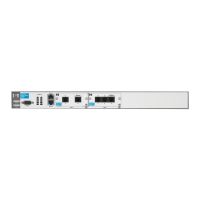B-40
Appendix B: Glossary
PON Passive Optical Network. A system that brings optical fiber cabling and signals
all or most of the way to the end user using passive equipment, which saves
power and cost. Depending on where the PON terminates, the system can be
described as Fiber-To-The-Curb (FTTC), Fiber-To-The-Building (FTTB), or
Fiber-To-The-Home (FTTH). See also FTTC, FTTB, or FTTH.
POP Point of Presence. An access point to the Internet. Your ISP or online service
provider has at least one POP on the Internet. A POP usually includes routers,
digital/analog call aggregators, servers, and, frequently, Frame Relay or ATM
switches.
Port The point of physical connection between a device and a circuit. The port’s
signaling capacity determines the greatest amount of data that can be trans-
mitted over the connection at any given time.
POTS Plain Old Telephone Service. A term used to describe the analog, voice-only
telephone service in the local loop.
PPP Point-to-Point Protocol. A suite of Data Link Layer protocols. PPP connects
two peers in an end-to-end link. To establish a PPP session, the two peers must
exchange frames, in order, from at least three protocols: LCP, an NCP, and
PPP. As its name suggests, PPP is typically used for Internet connections
originating from a dial-up line or a high-speed modem. For more information
on PPP, see RFC 1661 (at http://www.ietf.org/rfc/rfc1661.txt).
PPPoA Point-to-Point Protocol over ATM. A Data Link Layer network protocol that
encapsulates PPP frames in ATM AAL5 cells. PPPoA offers standard PPP
features such as authentication, encryption, and compression for cable
modem, DSL, or ADSL connections. If used as the connection encapsulation
method on an ATM-based network, PPPoA can slightly reduce overhead
(around 0.58%) in comparison to PPPoE. For more information on PPPoA, see
RFC 2364 (at http://www.ietf.org/rfc/rfc2364.txt).
PPPoE Point-to-Point Protocol over Ethernet. A Data Link Layer network protocol
that encapsulates PPP frames inside Ethernet frames. It is used mainly to
allow multiple users on an Ethernet network to connect to an ISP using the
same cable modem or DSL connection. PPPoE offers standard PPP features
such as authentication, encryption, and field compression. For more informa-
tion on PPPoE, see RFC 2516 (at http://www.ietf.org/rfc/rfc2516.txt).
PPTP Point-to-Point Tunneling Protocol. A protocol that allows organizations to
extend their own corporate network through private “tunnels” over the Inter-
net. PPTP encapsulates PPP frames and creates a tunnel for them to travel
across the IP network. For more information on PPTP, see RFC 2637 (at http:/
/www.ietf.org/rfc/rfc2637.txt).

